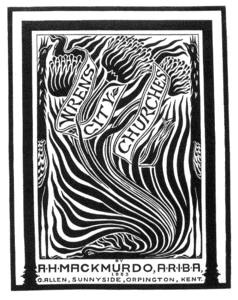Arthur Heygate Mackmurdo
Arthur Heygate Mackmurdo (12 December 1851 – 15 March 1942) was a progressive English architect and designer, who influenced the Arts and Crafts Movement, notably through the Century Guild of Artists, which he set up in partnership with Selwyn Image in 1882.

Early life
Mackmurdo was the son of a wealthy chemical manufacturer. He was educated at Felsted School, and was first trained under the architect T. Chatfield Clarke, from whom he claimed to have learnt nothing. Then, in 1869, he became an assistant to the Gothic Revival architect James Brooks. In 1873, he visited John Ruskin's School of Drawing, and accompanied Ruskin to Italy in 1874. He stayed on to study in Florence for a while; despite the influence of Ruskin, the Italian architecture he was most impressed by was that of the Renaissance.[1]
Career
In 1874 he opened his own architectural practice at 28 Southampton Street, in central London.
.jpg)
In 1882, Mackmurdo founded the Century Guild of Artists. Other members included Selwyn Image, Herbert Horne, Clement Heaton and Ruskin's protegee, the sculptor Benjamin Creswick.[1] It was one of the more successful craft guilds of its time. It offered complete furnishing of homes and buildings, and its artists were encouraged to participate in production as well as design; Mackmurdo himself mastered several crafts, including metalworking and cabinet making.
In 1884, the guild showed a display in the form of a music room at the Health Exhibition in London; the stand was shown, with variations, at subsequent exhibitions in Manchester and Liverpool. It incorporated two of Mackmurdo's favourite motifs. One was foliage twisted into sinuous curves.[1] Nikolaus Pevsner described Mackmurdo's use of such foliage on the title page of the designer's own Wren's City Churches (1883) as "the first work of art nouveau which can be traced", identifying its main influences as Rossetti and Burne-Jones, and ultimately, through them, William Blake.[2]
The second motif was the use of thin square columns, topped with flat squares instead of capitals. These columns influenced the furniture designs of C.F.A. Voysey, and, through him, Charles Rennie Mackintosh. Mackmurdo used them architecturally on his own house at 8 Private Road, Enfield (1887), and on a house for the artist Mortimer Menpes, at 25 Cadogan Gardens, Chelsea (1893–94), where he incorporated them into a kind of Queen Anne style.[1]
List of buildings
- 6 (Halcyon) (1874–6, now demolished) and 8 (Brooklyn) (1883) Private Road, Enfield
- 16 Redington Road, Hampstead (1889)
- 12 Hans Road, Chelsea (1894)
- 25 Cadogan Gardens, Chelsea (1893–4)
- 109–13, Charterhouse Street (1900)
- Great Ruffins, Great Totham (1904)
- Village Hall, Great Totham (1929-1930)
References
- Davey, Peter (1997). Arts and Crafts Architecture. London: Phaidon. pp. 56–7. ISBN 0-7148-3711-3.
- Pevsner, Nikolaus (1975). Pioneers of Modern Design. Harmondsworth: Penguin Books. p. 90. ISBN 0-14-020497-0.
- Victorian Web: A.H. Mackmurdo, an Overview ("Arthur Heygate Mackmurdo" throughout)
- Pamela Todd, The Arts and Crafts Companion: Introduction: Philosophy & Background
- Lambourne, Lionel (1980) Utopian Craftsmen: The Arts and Crafts Movement from the Cotswold to Chicago. London. Astragal Books